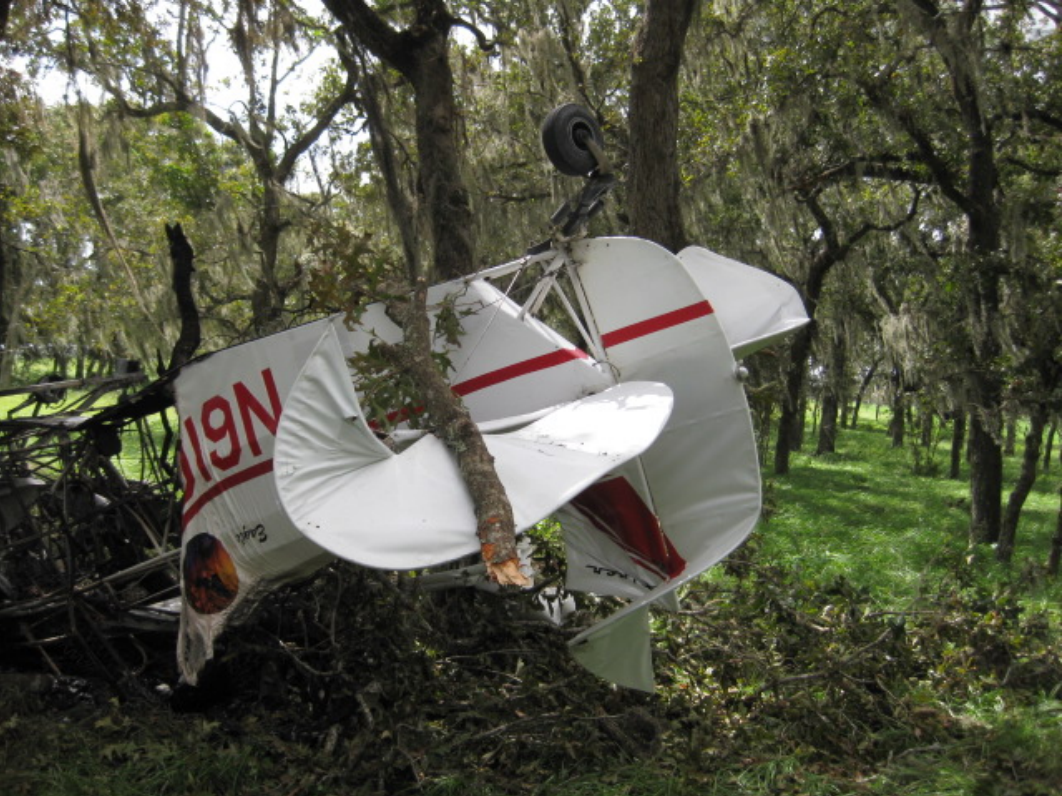
This information is added by users of ASN. Neither ASN nor the Flight Safety Foundation are responsible for the completeness or correctness of this information.
If you feel this information is incomplete or incorrect, you can submit corrected information.
| Date: | Wednesday 23 September 2020 |
| Time: | 07:50 |
| Type: |  Piper PA-25 Pawnee |
| Owner/operator: | Eagle Vistas LLC |
| Registration: | N6106Z |
| MSN: | 25-123 |
| Year of manufacture: | 1960 |
| Total airframe hrs: | 4179 hours |
| Engine model: | Lycoming O-320 |
| Fatalities: | Fatalities: 1 / Occupants: 1 |
| Other fatalities: | 0 |
| Aircraft damage: | Destroyed |
| Category: | Accident |
| Location: | near Inverness Airport (INF/KING), Floral City, FL -
 United States of America United States of America
|
| Phase: | Manoeuvring (airshow, firefighting, ag.ops.) |
| Nature: | Agricultural |
| Departure airport: | Inverness Airport, FL (INF/KING) |
| Inverness Airport, FL (INF/KING) | |
| Investigating agency: | NTSB |
| Confidence Rating: |
The commercial pilot departed a nearby airport to conduct agriculture spraying. During the third spray pass from west to east a witness observed the airplane abruptly pull up and then descend rapidly into a tree line after which an explosion and postcrash fire occurred. About 350 ft directly west of the main wreckage, a large dead tree with vegetation growth was present in the field being sprayed. The tree contained broken branches and components of the agricultural spraying equipment near its base. The spray fan nose cone exhibited a large dent impact signature.
It is likely that during the low spraying pass, the agricultural spraying equipment mounted on the bottom of the fuselage struck the dead tree. At some point prior to or after the collision, the pilot likely rapidly pulled up, but subsequently lost airplane control, and impacted a row of trees inverted. Examination of the airplane did not reveal any anomalies that would have precluded normal operation.
Multiple factors likely contributed to the airplane’s collision with the tree. The first factor was that the pilot’s spraying approach from west to east was toward the shorter portion of the field, which forced the pilot into making shorter low passes and reduced his time to see and avoid the tree. He had previously sprayed the field about 4 weeks prior to the accident from the north to south, which would have allowed for longer spray runs due to the field being oriented longer on a north/south direction.
Second, the sun had risen about 30 minutes prior to the accident and the sky was clear. It is likely that the eastward path presented the pilot with a combination of sun glare and shadows in the field due to the low sun angle and the row of trees that lined the eastern portion of the field. Lastly, the tree had significant vegetation growth that was similar to the color of the field being sprayed, which possibly camouflaged portions of the tree. These factors likely affected the pilot’s ability to see and avoid the tree.
The pilot had autopsy findings of moderate coronary atherosclerosis in one artery and was taking high blood pressure medications. These cardiovascular conditions placed the pilot at some increased risk for an acute cardiac event, however, there was no operational or medical evidence to suggest that occurred. Thus, it is unlikely that the pilot’s cardiovascular disease was a factor in the accident.
Toxicology results found that the pilot was taking medication for diabetes and likely had an elevated blood glucose on the day of the accident; however, there was no evidence to suggest that the pilot’s high blood glucose and diabetes contributed to the accident.
Toxicology testing also found evidence of the impairing drug cannabis. The levels found suggested that usage may have been some time earlier in the day. However, toxicology results alone cannot be used to prove that the user was experiencing effects of cannabis at the time of the accident. Metabolism and elimination depend on the means of ingestion, potency of the product, frequency of use, and user characteristics; information the medical investigation did not obtain. As a result, it could not be determined whether the pilot's use of a potentially impairing substance contributed to the accident.
Probable Cause: The pilot’s failure to see and avoid a tree while flying towards the rising sun during an aerial application flight, which resulted in a collision with the tree and a subsequent loss of airplane control.
Accident investigation:
 |
|
Sources:
https://www.baynews9.com/fl/tampa/news/2020/09/23/authorities--1-person-killed-in-single-engine-plane-crash-in-citrus-county
NTSB
Location
Images:

Photo: NTSB
Media:
The NTSB is investigating the crash Wednesday of a Piper PA25 airplane in Floral City, Florida. The NTSB is not traveling to the scene of the crash at this time.
— NTSB_Newsroom (@NTSB_Newsroom) September 23, 2020
Revision history:
| Date/time | Contributor | Updates |
|---|---|---|
| 23-Sep-2020 13:12 | gerard57 | Added |
| 23-Sep-2020 13:29 | gerard57 | Updated [Source] |
| 23-Sep-2020 16:01 | Captain Adam | Updated [Aircraft type, Operator, Location, Nature, Embed code, Narrative] |
| 24-Sep-2020 15:11 | RobertMB | Updated [Registration, Cn, Operator, Phase, Nature, Source, Embed code, Narrative] |
| 24-Sep-2020 15:27 | Captain Adam | Updated [Narrative] |
| 27-Feb-2021 19:20 | rudy | Updated |
| 29-Jun-2022 12:20 | Captain Adam | Updated [Time, Departure airport, Destination airport, Source, Narrative, Category, Accident report, Photo] |
Corrections or additions? ... Edit this accident description
The Aviation Safety Network is an exclusive service provided by:


 ©2024 Flight Safety Foundation
©2024 Flight Safety Foundation